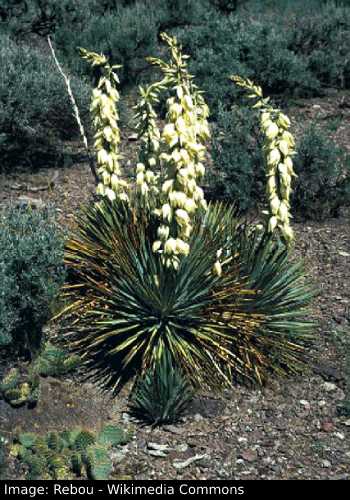35 Types of Yucca Plants (With Pictures) – Identification Guide
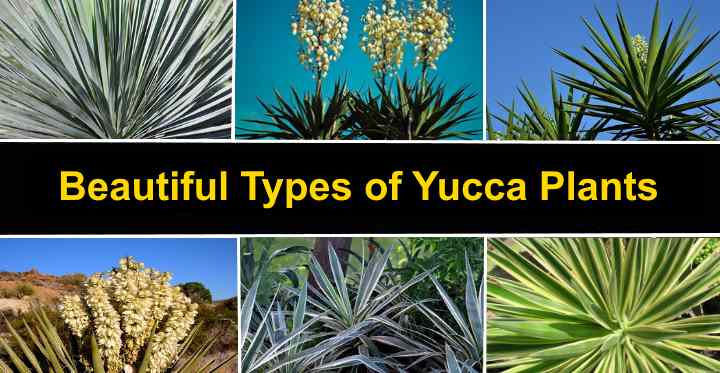
Yucca plants are famed for their large, spiky leaves growing on the top of long, thick woody stems. Many species of yucca plants are ideal ornamental plants for garden landscapes. Yucca plants have the appearance of palm trees, so growing them in your backyard or indoors can create a tropical look.
There are nearly 50 species of yucca trees and shrubs. Although sometimes called a type of cactus, yuccas are not cacti but are perennial evergreen shrubs and trees in the plant family Asparagaceae.
Some yucca plants can look like trees because their leaves grow on thick cane stems. Other yucca varieties look like shrubs. Yuccas can be identified by their distinctive sword-like spiky leaves and their white or whitish flowers growing on stems. Yuccas have foliage ranging in color from green to bluish-green. Some yucca varieties have yellow or white variegation.
This article describes some of the most popular yucca plants for growing outdoors or indoors. Along with their scientific name and descriptions, pictures of yucca plant varieties will help identify them.
Types of Yucca Plants (With Pictures) – Identification Guide
Here are some common types of yucca plants to enhance your garden landscape.
Adam’s Needle and Thread Yucca Plant (Yucca Filamentosa)
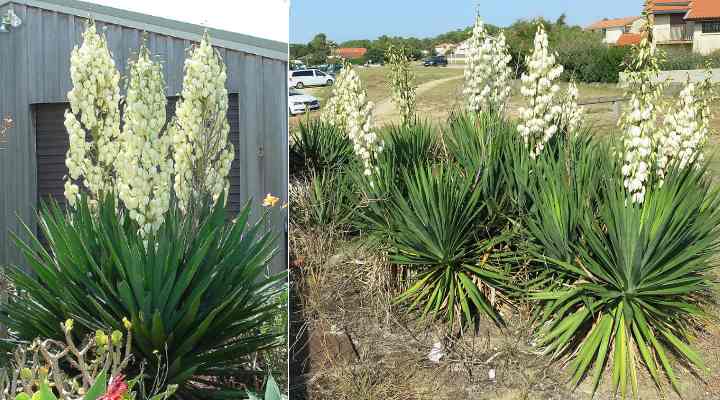
You can identify Yucca filamentosa by its white filaments along the leaf margins
Adam’s needle is a variety of flowering yucca that produces a dramatic tall stalk. The panicle has a massive cluster of white flowers and can reach up to 8 ft. (2.4 m) high. The Yucca filamentosa thrives in USDA zones 4 – 11 and is cold hardy down to 5°F (-15°C).
Also named the common yucca, Adam’s needle and thread yucca is a popular evergreen landscape plant. The yucca shrub has long sword-shaped green leaves that grow up to 3 ft. (1 m) tall. The sharp, spine-tipped foliage forms a clump up to 3 ft. (1 m) wide.
An identifying feature of Adam’s needle and thread yucca plants are the thin filaments in their foliage. These thread-like growths are the reason why the yucca’s botanical name is filamentosa, and its common name is ‘needle and thread.’
Adam’s Needle ‘Color Guard’ (Yucca filamentosa ’Color Guard’)
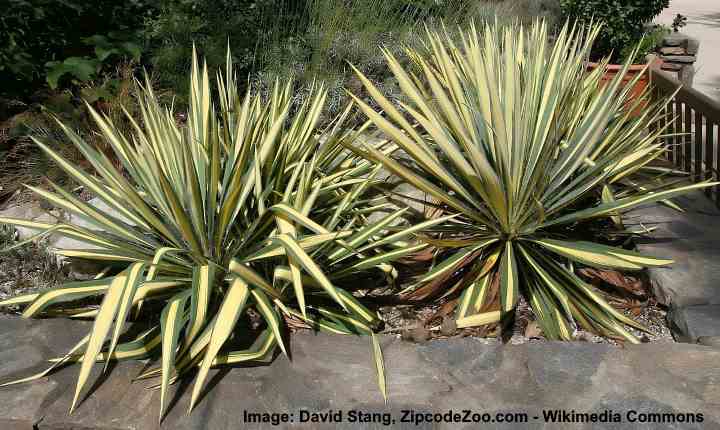
Yucca filamentosa ’Color Guard’ has ornamental variegated green and yellow leaves
The Yucca ‘Color Guard’ is a spectacular type of Yucca filamentosa. The yellow and green variegated leaves identify this variety of yucca. You’ll also notice that the foliage grows in a rosette form and has distinctive curly threads in the leaves that become pink and rose-colored in the winter.
This variegated Adam’s needle and thread yucca plant grows as a clumping shrub that is 2 to 3 ft. (0.6 – 1 m) tall and the same width. A large cluster of whitish flowers emerges on a long stalk in the middle of June. Grow the sun-loving yucca in sandy soil. Ideal as a garden border shrub where its sharp leaves will deter animals and intruders.
Adam’s Needle ‘Excalibur’ (Yucca filamentosa ‘Excalibur’)

Yucca filamentosa ‘Excalibur’ has decorative bluish silvery green foliage
Adam’s Needle ‘Excalibur’ is a stubbing yucca variety. Also called the thready yucca, the shrub has stiff, sword-shaped leaves that have a bluish-green to gray-green color. Looking at pictures of this yucca cultivar, you will see the curly filaments growing among the foliage.
During summer, Adam’s needle yucca produces a large cluster of bell-shaped creamy-white flowers. This cluster sits proudly on the top of a 5-ft. (1.5 m) high flowering stem. Plant this yucca in the backyard where you need to create a dramatic statement. Ideal for growing in USDA zones 5 – 10.
Spineless Yucca Plant (Yucca Elephantipes)
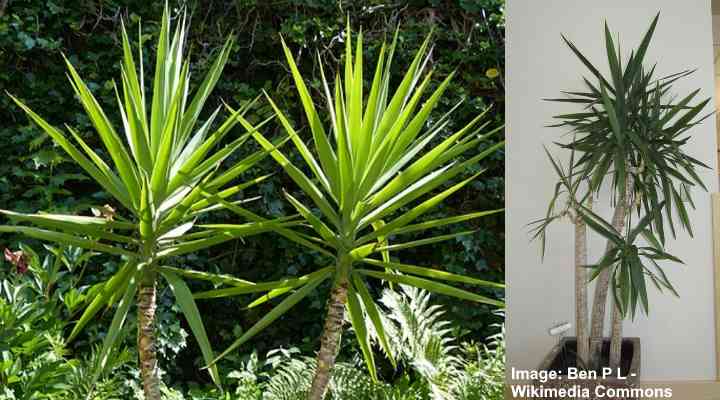
Yucca Elephantipes can be grown indoors as a houseplant as its leaves are not sharp
One of the tallest yucca trees is the spineless yucca. Its common name comes from the lack of sharp spines on the leaves. As the yucca plant matures, its thick gray stem begins to resemble an elephant’s foot—hence the botanical name ‘elephantipes.’
The distinctive feature of the spineless yucca is its smooth leathery evergreen leaves. These leaves grow in a spiral rosette shape, making the yucca tree look like a tropical palm tree. In the garden landscape, the hardy yucca plant grows up to 30 ft. (9 m) high.
Spineless yuccas are one of the few yucca plants suitable as a houseplant. As an indoor plant, spineless yuccas only grow to about 5 ft. (1.5 m) high. However, its slow growth means that this tall indoor plant takes many years to reach that height.
Related: Yucca Elephantipes (Spineless Yucca): Complete Care Guide
Spanish Bayonet (Yucca Aloifolia)
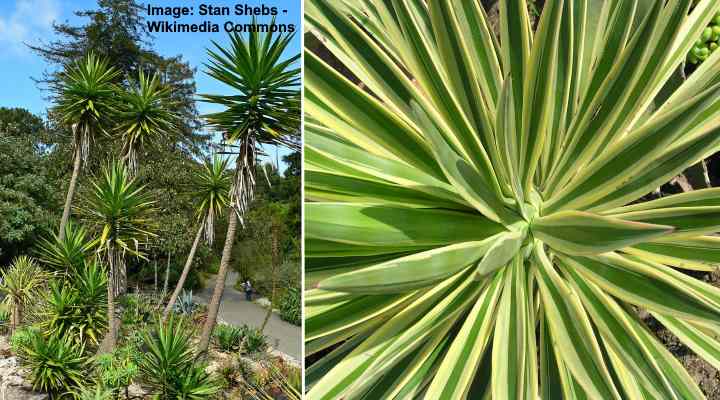
Yucca aloifolia can grow tall outdoors but you can also grow it indoors. Right image: Yucca aloifolia ‘Variegata’
The Spanish bayonet multi-stemmed yucca plant is one of the most ornamental of the yucca species. As its name suggests, the leaves are long and sword-like. It’s not just the leaf shape that looks like a sword—the stiff evergreen blades also have sharp serration along the margins and a sharp pointed tip. A cluster of white flowers appears on 2-ft. (0.6 m) long flowering stems.
Also called the Spanish dagger, the tall yucca shrub-like tree grows to between 5 and 10 ft. (1.5 – 3 m). Densely growing spiky leaves form crowns on multiple stems. The yucca tree compliments other tropical trees and is ideal for growing in arid landscapes in coastal regions. This yucca species Yucca aloifolia thrives in USDA zones 7 – 11.
This palm-like yucca plant also grows well indoors as a tropical plant.
Weak-Leaf Yucca Plant (Yucca flaccida)

Yucca flaccida can be identified by its sword-like leaves that tend to droop
The weak-leaf yucca has leaves that tend to droop or bend over. The low-growing evergreen shrub only grows up to 2 ft. (60 cm) tall with a spread of up to 5 ft. (1.5 m). As with most yuccas, the plant species is identified by its sword-shaped leaves with sharp points.
Another common name for this yucca shrub is Adam’s needle. Botanically speaking, the species is related to Yucca filamentosa.
When the yucca produces flowers, it has a mass of bell-shaped white flowers on the end of long stems. Stunning cultivars of this yucca are the ‘Garland Gold’ or ‘Golden Sword’ with a rosette growth of spectacular yellow and green leaves.
Spanish Dagger (Yucca gloriosa)
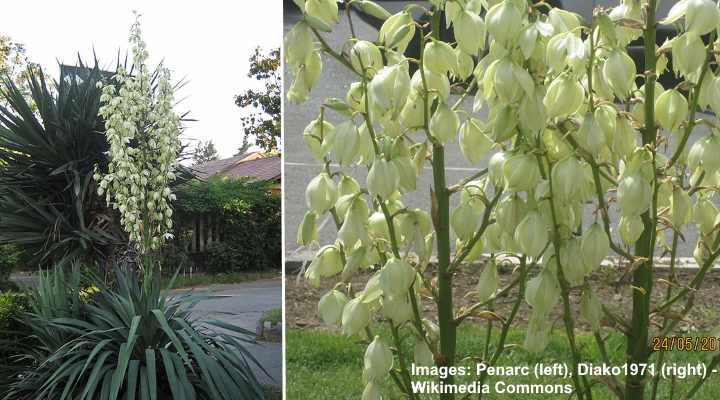
Yucca gloriosa is a hardy ornamental plant that adds focal point to any garden
Yucca gloriosa shares a common name among other yuccas—the Spanish dagger, and grows on sandy soil in warmer climates. It has sword-like narrow dark green leaves and is usually multi-stemmed. It grows to about 8 ft. tall (2.5 m), and its panicle has white flowers which sometimes have a purple-red hue.
Yucca gloriosa has several cultivars such as ‘Variegata’ and ‘Bright Star’. Yucca gloriosa ‘Bright Star’ is an attractive ornamental shrub that has brightly-colored green leaves with yellow margins. The rigid, sharp leaves grow in a rosette pattern and can grow between 2 and 4 ft. (0.6 – 1.2 m) tall.
The ‘Bright Star’ yucca tolerates full sun and thrives in sandy, well-draining soil. The spiky yellowish shrub thrives in USDA zones 7 – 11 and is cold hardy down to 0°F (-17°C). When the temperature drops, the leaves take on a light reddish-pink hue.
Red Yucca Plant (Hesperaloe parviflora)
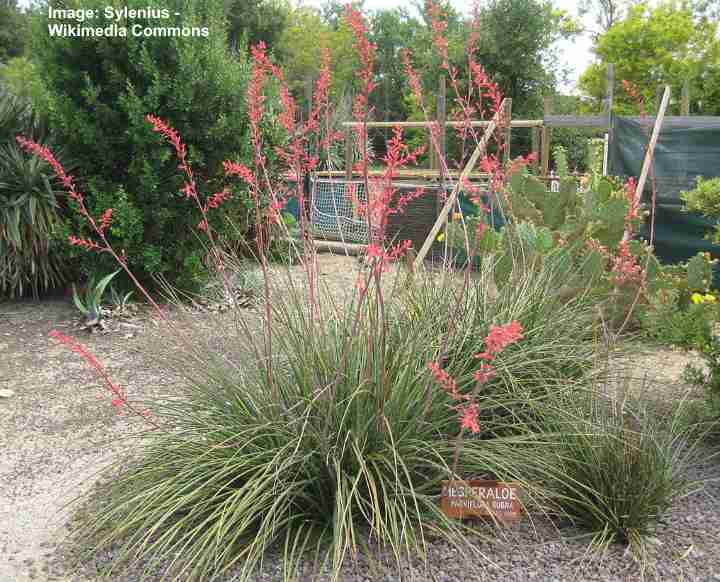
Red yucca is not a true type of yucca plant and is identified by spineless leaves that turn reddish color in cold weather
The red yucca plant can be identified by its grass like leaves and pinkish flowers that grow on tall narrow spikes. This is not a real species of yucca, and this bushy shrub has spineless leaves that grow in a rosette shape. This yucca-like plant gets its name from the way the bluish-green leaves turn reddish-bronze in cold weather.
Similar to yucca plants, the red yucca (Hesperaloe parviflora) produces dainty bell-shaped red or dark pink flowers on the end of tall, 5-ft. (1.5 m) stems.
The red yucca plant is drought tolerant and is suitable for planting in borders, containers, and Mediterranean gardens. Because the leaves are spineless—unlike most yucca species—they won’t cause any injury to humans or animals. The red yucca grows well in USDA zones 6 – 11.
You should still take care if you have pets in your garden. Species of yucca plants are toxic to cats and dogs. And the red yucca also contains poisonous substances.
Joshua Tree (Yucca brevifolia)
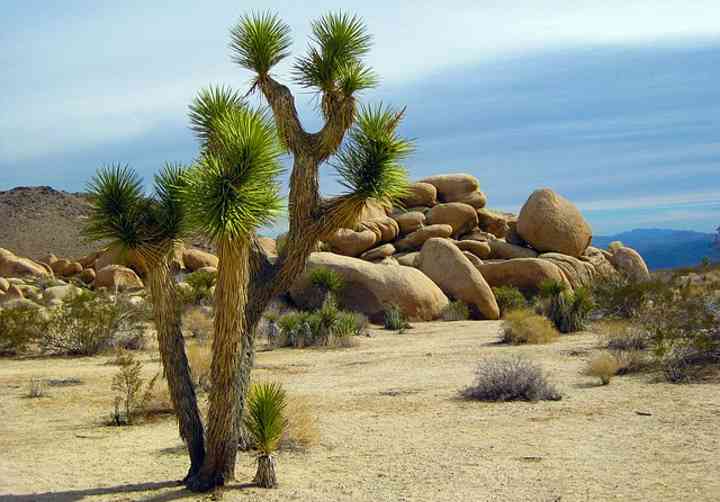
Joshua tree is a type of yucca commonly found in Mojave Desert
The Joshua tree is a type of fast-growing desert tree that is symbolic of the Mojave Desert in arid southwestern U.S. You can identify the Joshua tree yucca by its thick, fibrous trunk that divides into thick branches. Compact clumps of spiky sharp dark-green leaves crown each of the branches.
Joshua trees grow to about 49 ft. (15 m) tall, and their roots can reach down to 36 ft. (11 m) to search for moisture. The yucca tree produces clusters of creamy white flowers in late winter and early spring.
The Yucca brevifolia ‘Blue’ is the Blue Joshua tree – a rare type of yucca tree with bluish-green leaves. Another name for this yucca tree is the ‘Sonoran Blue.’
Soapweed Yucca Plant (Yucca glauca)
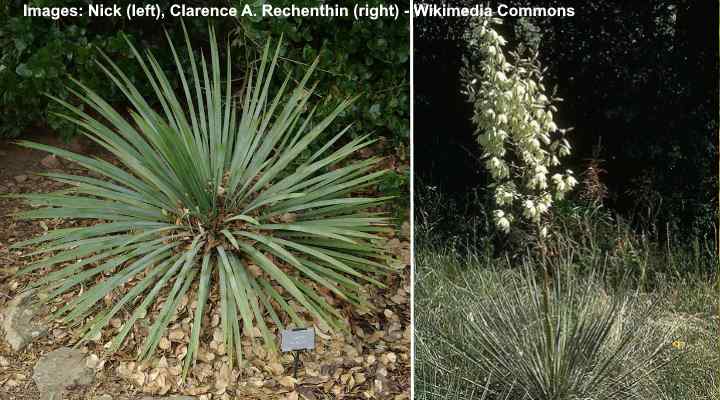
Yucca glauca is a small type of yucca plant identified by narrow leaves and round growth habit
Another type of shrubby yucca is the soapweed yucca—a drought-tolerant plant that grows in deserts. The small sharp-leafed yucca plant thrives in arid conditions. You can identify the plant by its long, narrow spiky leaves and globular growth habit. The low-growing desert shrub grows about 2 ft. (0.6 m) tall and wide.
When the soapweed yucca plant blooms, it produces pale green-white flowers on the end of a flowering stem that is 3 ft. (1 m) tall. Although this yucca shrub is also called the Spanish Bayonet, it is a different species from the Yucca Aloifolia. The cold-hardy yucca thrives in USDA zones 4 – 8.
Banana Yucca Plant (Yucca baccata)
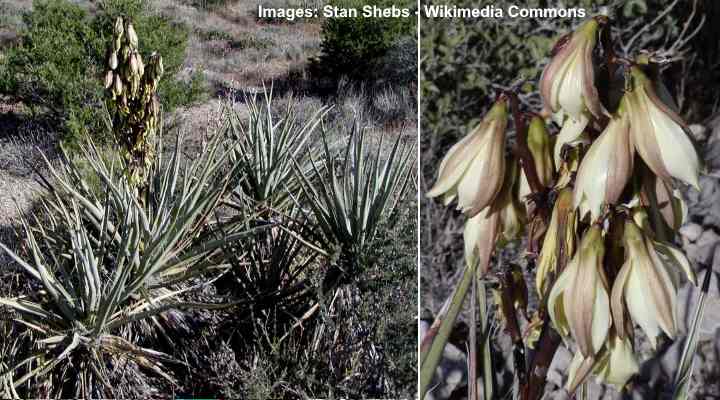
Banana yucca gets its name from its banana-shaped fruit
The banana yucca plant is a perennial evergreen shrub that is native to arid deserts in the U.S. and Mexico. Only growing to 3 ft. (1 m) tall, the Yucca baccata has long thin spiked leaves that are between 1 and 3 ft. (0.3 – 1 m) long. One of the differences between the banana yucca and other yucca species is that its flower stalks don’t grow as tall.
To identify the banana yucca, look at the fruit it produces. After blooming with whitish flowers, banana-shaped fruits appear. The banana yucca grows in zones 4a – 9a. The short, spiky shrub is related to the next plant on this list of popular yuccas—the Mojave yucca.
Mojave Yucca Plant (Yucca schidigera)
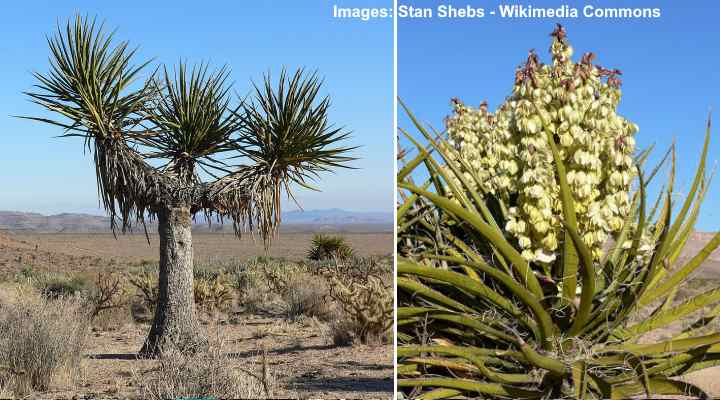
Yucca schidigera is a type of yucca tree native to deserts in southeastern California
The Mojave yucca is another type of yucca with the common name ‘Spanish dagger.’ As its name suggests, the yucca plant is native to the Mojave Desert and has dangerously sharp leaves. Unlike its cousin, the banana yucca shrub, the Mojave yucca is a type of tree that grows to 16 ft. (5 m).
The Mojave yucca plant looks like a medium-sized tree with spiked green crowns. The sharp, stiff foliage is a yellowish-green or bluish-green color. A bulbous cluster of white flowers with a purple tinge blossom at the end of a 4-ft. (1.2 m) flower stem.
Beaked Yucca Plant (Yucca rostrata)
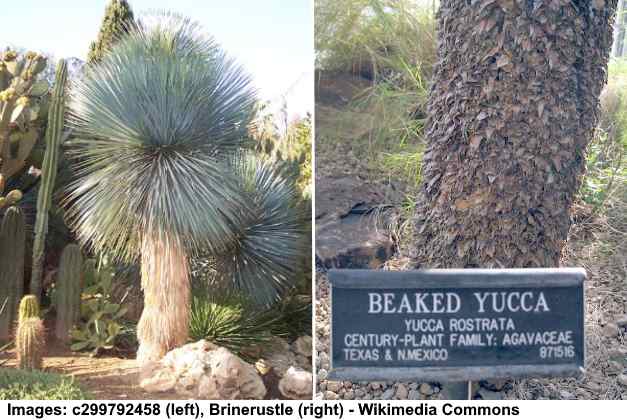
Yucca rostrata is cold hardy tree-like yucca with blue-green foliage
The beaked yucca is a spectacular single-stemmed yucca tree with a stunning spray of bluish-green leaves radiating from the trunk’s top. The crown of foliage is a round pom-pom shape that contains hundreds of sharp thin blades that are 2 ft. (0.6 m) long. To add to the yucca tree’s ornamental appeal, a large cluster of white flowers emerge from the foliage.
This yucca tree grows between 6 and 15 ft. (1.8 – 4.5 m) tall. It’s a cold-hardy type of plant and grows in USDA zones 5 – 11 and withstands temperatures as low as -10°F (-23°C).
The Yucca rostrata shouldn’t be confused with the Mexican blue yucca (Yucca rigida). The Yucca rigida isn’t as cold-hardy as the beaked yucca, and it has stiffer leaves.
Buckley’s Yucca (Yucca constricta)
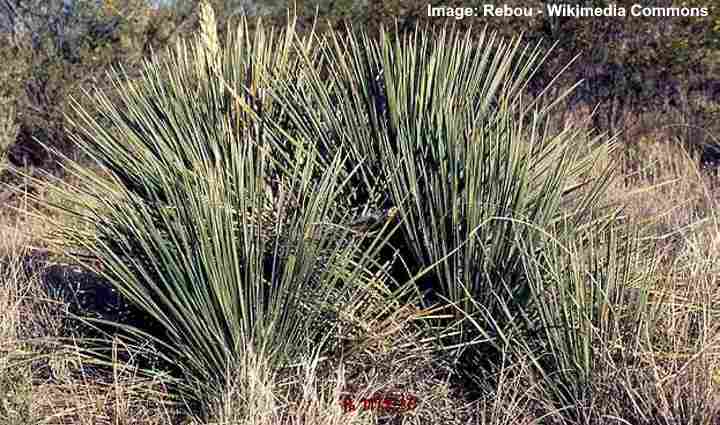
Yucca constricta doesn’t usually have a trunk and sometimes grows in clumps
Buckley’s yucca plant is an evergreen perennial shrub that thrives in rocky, sandy soil in hot deserts. This yucca variety usually grows in stemless clumps between 1 and 3 ft. (0.3 – 1 m) tall. Buckley’s yucca is identified by its narrow, twisting leaves that are greenish-blue to dark green.
Buckley’s yucca is ideal for landscapes that have poor, infertile soil. Looking up close, you’ll also see thread-like filaments growing among the foliage. Tall flowering panicles up to 5 ft. (1.5 m) rise from the middle of the plant when it blooms.
Twisted Yucca (Yucca rupicola)
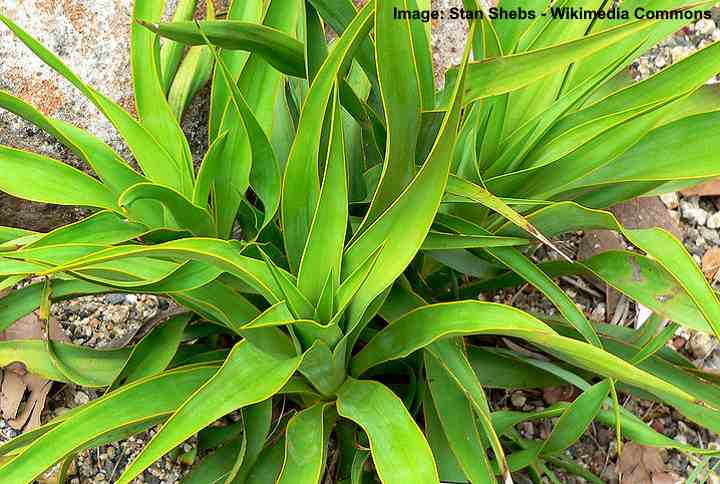
Yucca rupicola is characterized by its twisting leaves and low growth
Twisted yucca is also named Texas yucca, rock yucca, and twisted-leaf yucca. Its twisting sword-shaped leaves are bright green to dark green. As with most species of outdoor yuccas, care is essential when handling the plants as they have sharp leaves with cutting edges and pointed tips.
The low-growing yucca plant grows in clumps of rosettes. The lanceolate leaves are up to 2 ft. (0.6 m) long and start to twist as they mature. As with most species of flowering yuccas, a flowering stalk up to 5 ft. (1.5 m) emerges from the plant, producing clusters of white, bell-shaped drooping flowers.
Our Lord’s Candle (Yucca whipplei)
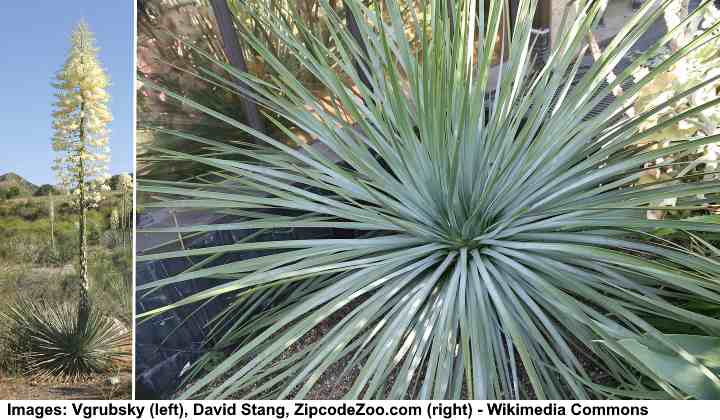
Yucca whipplei is a trunkless cold hardy yucca with blue-green leaves and a very tall flower stalk
Our Lord’s Candle is an evergreen yucca shrub that grows on the ground without a trunk. The bluish-green leaves are rigid and sharp, with piercing serrated edges. The stiff blades grow up to 3 ft. (1 m) long. The striking feature of this yucca plant is the stunning flower stalk. The yucca produces a flowering stem up to 14 ft. (4.2 m) tall. The crowning glory of the yucca is its mass of scented creamy-white flowers.
The Yucca whipplei is a species of yucca that dies after flowering. However, offsets from the mother plant usually grow in its place. Grow this spectacular yucca as an accent plant in an ornamental garden. The ‘Our Lord’s Candle’ yucca thrives in USDA zones 7 – 9 and is cold hardy down to 10°F (-12°C).
Dwarf Yucca (Yucca harrimaniae)
The dwarf yucca plant can be recognized by its spiky clusters of grayish-green leaves and tall flower stalks that have downward-hanging, greenish-white flowers. This yucca variety can reach heights of up to 1.3 feet (0.4 meters), with its flower stalk growing as tall as 4 ft. (1.2 meters).
Native to southwestern U.S., the dwarf yucca plant thrives in hot, desert-like environments. For optimal growth, cultivate this species in well-draining soil that is sandy or loamy, and ensure it receives full sunlight. This yucca variety is ideal for growing in USDA zones 6 – 9.
Thompson’s Yucca (Yucca thompsoniana)

The Thompson’s yucca, native to Texas, is recognizable by its greenish-blue, serrated leaves arranged in a rosette formation on an erect trunk. From April to May, it produces attractive, creamy-white flowers that grow on 3 – 5 ft. (0.9 – 1.5 m) tall flower stalks. Another feature of this plant is its capsule-shaped fruits with dull-black seeds. This yucca tree can reach up to 6 – 12 ft. (1.8 – 3.6 m) tall.
The Thompson’s yucca variety is drought-tolerant and can withstand temperatures as low as 10°F (-12°C). For best results, grow this tree in full sun and in any well-draining soil. The Thompson’s yucca grows well in USDA zones 7 – 11.
Mountain Yucca (Yucca × schottii)
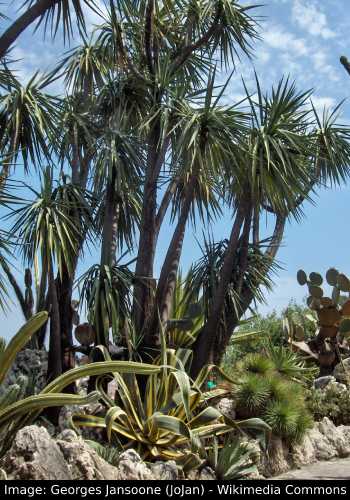
The mountain yucca is an evergreen shrub known for its rosette of spiky, lanceolate leaves that are bluish-green in color. Some other identifying features of this plant are its bell-shaped, white flowers, thin trunk, and fleshy, egg-shaped fruits. The plant can grow up to 10 ft. (3 m) in height.
The mountain yucca is native to Arizona and is one of the very few yuccas that are found at extremely high elevations. It is also one of the few yuccas tolerant of partial shade and extremely low temperatures, down to around -10°F (-23°C). Grow this plant in sandy or rocky, well-drained soil. This shrub flourishes in USDA zones 5 – 10.
Soaptree Yucca (Yucca elata)
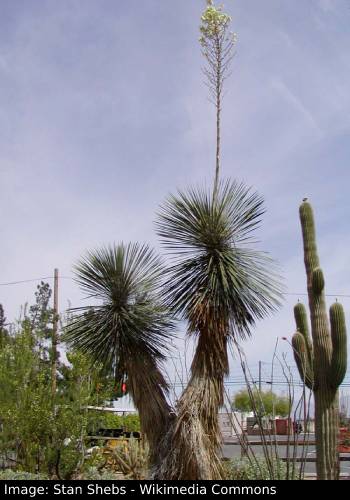
Renowned for its striking appearance, the soaptree yucca is an ornamental plant featuring a tall flowering stalk and fibrous leaves that form a shaggy skirt around its trunk. The flowers grow together in tight clusters, displaying hues of white and even greenish-pink. The rosette is positioned atop the trunk and consists of slender, sword-shaped leaves with a blue-green to gray-green hue. This variety can reach a height of 12 – 20 ft. (3.6 – 6 m).
The soaptree yucca is often cultivated for its soap, which can be obtained from its root or trunk. It can be grown in full sun in most soils, as long as they are well-drained. In addition, it is also tolerant of drought, heat, and frost. This plant is cold-hardy down to 0°F (-18°C) and grows in USDA zones 6 – 11.
Narrowleaf Yucca (Yucca angustissima)
The narrowleaf yucca is an evergreen shrub characterized by its long, narrow blue-green to yellow leaves and curling, white filaments. It produces creamy-white, bell-shaped flowers that grow on stalks up to 7 ft. (2 m) tall. Fruits are capsule-shaped with black seeds.
Native to southwestern U.S., this plant is found in semi-arid environments such as open shrublands and deserts. It thrives in any soil but prefers sandy or loamy soil that is mildly alkaline, as well as full sun. It grows best in USDA zones 4 – 9.
Pale Leaf Yucca (Yucca pallida)

The pale leaf yucca can be identified by its beautiful, symmetrical rosette of pale, blue-gray leaves with a waxy coating. The plant produces large, pure-white, bell-shaped flowers. It can grow up to 1 – 2 ft. (0.3 – 0.6 m) tall with a spread of 2 – 3 ft. (0.6 -1 m).
The pale leaf yucca is native to north-central Texas and is drought- and shade-tolerant. It is also tolerant of temperatures down to -10°F (-23°C). This type of yucca is ideal for growing in USDA zones 6 – 10.
Giant White Yucca (Yucca faxoniana)
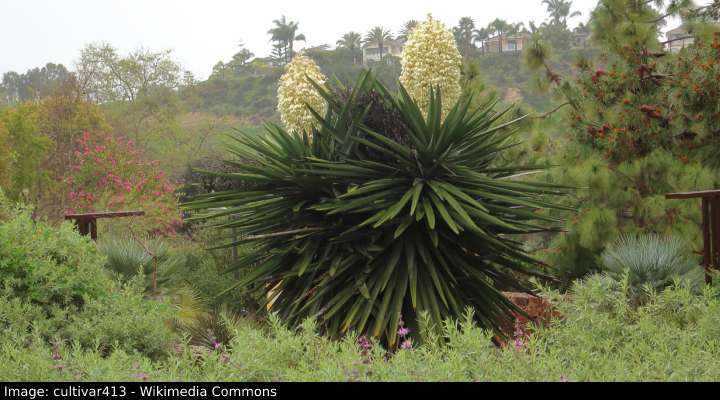
The giant white yucca is a large, evergreen shrub native to southwestern Texas. This plant has glossy, sword-shaped, dark-green leaves and produces beautiful ivory-colored, bell-shaped flowers on tall stems, reaching about 2 ft. (0.6 m) in height. The plant itself can reach heights of up to 15 ft. (4.5 m) with a spread of up to 10 ft. (3 m).
The giant white yucca thrives in arid, desert-like environments. The leaves of this plant were used by Native Americans for making baskets, cloth, and sandals, while the fibers were utilized for making rope. This yucca variety is drought- and heat-tolerant, as well as hardy down to around 10°F (-12°C). In addition, it thrives in full sunlight, well-drained soil, and is ideally suited for USDA zones 5 – 10.
Chihuahua Dwarf Yucca (Yucca endlichiana)

The chihuahua dwarf yucca is a rare yucca variety, distinguished by its upright rosette of stunning blue-green leaves and flowers with a dark-red outer color and white interior. This yucca species is an evergreen perennial that can grow up to 1.5 ft. (0.5 m) in height.
The chihuahua dwarf yucca grows best in well-drained, slightly alkaline soils and full sunlight. The plant is resistant to drought and can survive in temperatures as low as 15°F (-9°C) and even 5°F (-15°C). This plant is well-suited for USDA zones 8 – 10.
Palma China Yucca (Yucca filifera)
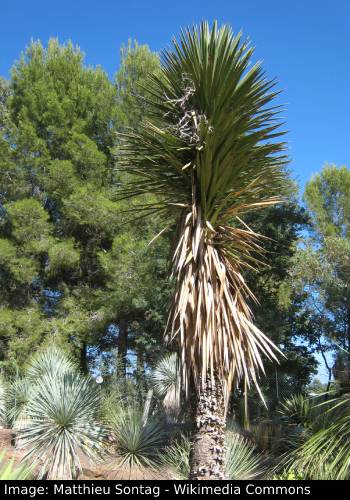
The palma china yucca is an evergreen tree with a tall, prominent trunk and pointy, upward-facing leaves that produce hanging filaments. The tree can occasionally be multi-stemmed but is usually single-stemmed. During summer, it produces clusters of creamy-white, bell-shaped flowers. The tree is fast-growing and can reach a height of up to 33 ft. (10 m).
The palma yucca is native to the Chihuahuan desert in north-eastern Mexico, and has become a popular ornamental and street plant over the years due to its striking appearance. It is drought- and salt-tolerant, as well as cold-tolerant down to 17.5°F (-8°C). It grows best in full sun, in well-drained soil, and between USDA zones 6 – 9.
Queretaro Yucca (Yucca queretaroensis)

The Queretaro yucca stands out as one of the most attractive yuccas, featuring a single trunk topped with a perfectly circular rosette of slender, vibrant green leaves. The tall and robust trunk is surrounded by a tidy skirt of dead leaves. The flower stalk rises 3 ft. (1 m) above the crown and bears creamy-white flowers. This Mexican native can reach heights of up to 8 to 12 ft. (2.4 to 3.6 m).
In its native habitat, the Queretaro yucca flourishes in the rugged, semi-arid climate of Mexico’s central mountain range. This yucca plant grows best in full sun (though it may be able to tolerate light shade) and any well-draining soil. This yucca variety is ideal for growing in USDA zones 9 – 11.
Jalisco Yucca (Yucca jaliscensis)
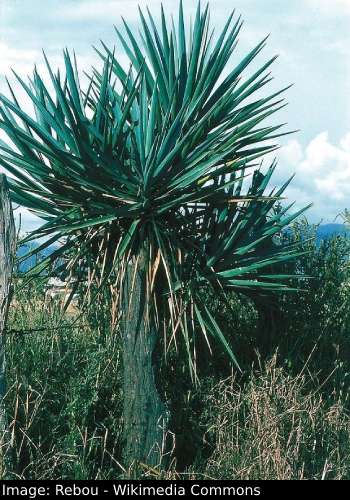
The Jalisco yucca is a tall, evergreen, tree-like yucca with a thick, single-stemmed (occasionally multi-stemmed) branch and blue-green leaves. It is characterized by its drooping fruit covered with thick hairs, as well as its ball-shaped, white flowers that can bloom all year round. This yucca variety can reach heights of up to 33 ft. (10 m) and has a spread of up to 20 ft. (6 m).
The Jalisco yucca is prevalent in the Pacific coastal regions of south-central Mexico and is popularly cultivated for its decorative appeal. The plant is self-cleaning, drought-tolerant, and can be grown in most soil types. It grows best in full sun and in USDA zones 8 – 10.
Giant Spanish Dagger (Yucca carnerosana)
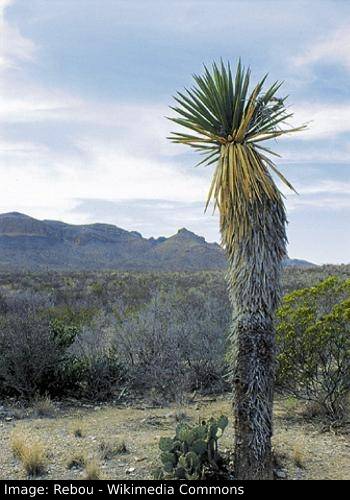
The giant Spanish dagger is a yucca species that resembles a tree, featuring a sturdy stem and a stunning rosette of sharp, vibrant green leaves. Its creamy-white blossoms are frequently cultivated due to their striking beauty. The trunk of this tree is covered in a dense skirt of dead, fibrous leaves. This yucca variety can reach heights of up to 20 ft. (6 m).
The giant Spanish dagger is often found in northern Mexico, though it can also be found in parts of western Texas. This plant prefers slightly alkaline soil, though it is adaptable to many soil types. In addition, it is drought-tolerant and thrives in full sunlight. This yucca variety is ideally suited for USDA zones 5 – 10.
Yucca declinata
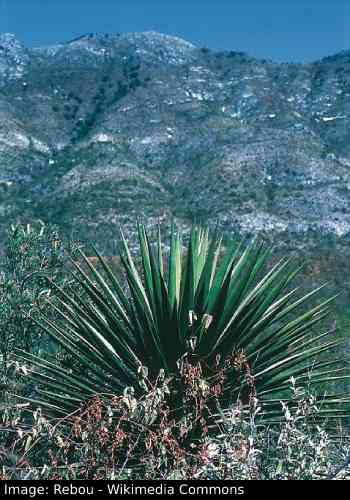
Native to northwestern Mexico, yucca declinata is unique among yuccas due to its horizontally oriented, 4.2 ft (1.2 m) long flower stalk. This yucca species produces small, white flowers and oblong fruits with flat, egg-shaped seeds. The leaves are lanceolate with a blue-green color. This plant resembles a tree and can reach a height of up to 19.5 ft (6 m).
Yucca valida

Yucca valida is a single- or multi-trunked yucca variety with a rosette of blue-green, lance-shaped leaves. The foliage has a yellow-green hue and forms a persistent skirt around the base of the trunk upon withering. The creamy-white flowers bloom on stalks and are known for their outstanding fragrance, reminiscent of dill. Another feature of this plant is its black, oblong, juicy fruits. This plant can reach up to 23 ft. (7 m) in height.
Yucca utahensis

Yucca utahensis, native to the southwestern U.S., is known for its gray-green, slender, needle-like leaves, which can grow up to 2.3 feet (70 cm) in length. Additionally, it produces capsule-shaped fruits containing black seeds.
Yucca utahensis produces large, creamy-white flowers that grow on stalks up to 5 ft. (1.5 m) in height. Its common habitat includes sandy areas such as the Mojave Desert. This yucca variety can reach a height of up to 10 ft. (3 m).
Tropical Yucca (Yucca lacandonica)

Yucca lacandonica is known for being the only type of yucca that is often epiphytic (which means that it grows on other trees). It is characterized by its unique, tropical appearance and slender, dark green leaves that can reach up to 33.5 inches (85 cm) in length. It produces showy, creamy-white flowers and juicy, oblong-shaped fruits. It is native to Belize and southern Mexico, where it is found in tropical rainforests.
Yucca mixtecana
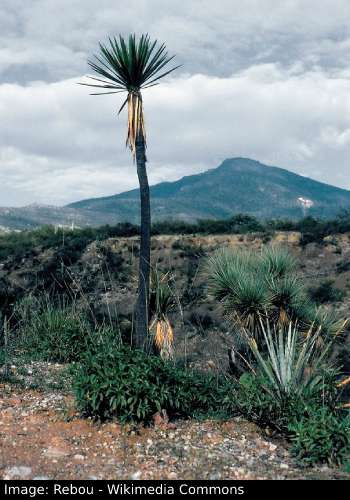
Yucca mixtecana is native to southern Mexico and is renowned for its unbranched, long, slender trunk and rigid, blue-green to gray-green leaves. This tree is further characterized by its evergreen nature and tree-like appearance, making it a popular choice for ornamental planting. This yucca species can reach heights of up to 20 ft. (6 m).
Potosí palm soapwort (Yucca potosina)

Potosí palm soapwort resembles a palm tree, featuring a tall trunk and a symmetrical rosette of dark-green to blue leaves covered with twisted gray threads. Another feature of this tree is its huge flower spike with cream-colored, elongated flowers. It is known for being frost- and drought-tolerant. It is cold hardy down to around 14°F (-10°C).
Yucca treculiana
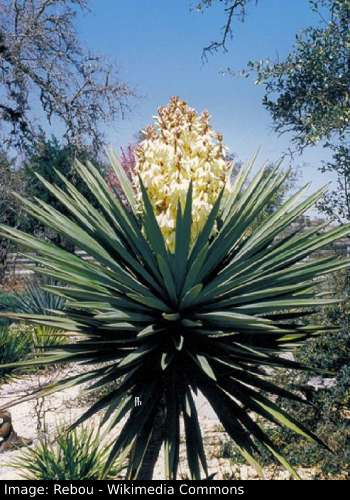
Yucca treculiana is a large tree- to shrub-like yucca variety that can reach up to 33 ft. (10 m) in height. This plant showcases thick leaves that come in blue-green to yellow shades, with fibers on the edges. It also grows delightful cream-colored flowers, occasionally tinged with purple, as well as long, fleshy, succulent fruits. It is native to parts of southern U.S. and northern Mexico.
Yuca Flowers
One remarkable feature of yuccas is their ability to produce large clusters of flowers. Flower stalks emerge from the center of the plant and can reach impressive heights of up to 12 feet (3.6 meters).
The shape of yucca flowers can be described as bell-shaped or tubular. The petals of yucca flowers typically form a tubular structure that flares out at the base, resembling the shape of a bell or a trumpet.
Yucca flowers have a wide array of captivating colors, offering more than just white blooms. While numerous yucca species produce stunning creamy-white flowers, there are also varieties that showcase blossoms in various hues. These colors include pale yellow, soft pink, and even delicate shades of green. The specific flower color of yucca plants depends on their species and variety. This diverse range of colors enhances the visual appeal and versatility of yucca plants, making them a fantastic choice for landscaping and garden designs.
The Best Soil For Yuca Plants
Yucca shrubs and trees thrive in dry sandy soil and plenty of sunshine. All species of yuccas grow in most types of soil, as long as the ground is well-draining and not too rich. In garden landscapes, yucca plants grow as ornamental shrubs and will occasionally flower. But due to their sharp leaves, it’s best to plant them away from areas where people or pets frequent.
Growing Yuca as a Houseplant
As a houseplant, the Yucca elephantipes (spineless yucca / stick yucca) grows in pots in bright sunlight and average room temperatures. Spineless or stick yuccas are ideal for growing indoors as they have soft broad leaves without sharp spines. Unfortunately, it’s rare when indoor species of potted yucca plants flower.
How to Care for Yucca Plants
Yucca plants—both the indoor and outdoor varieties—are low-maintenance plants. Once established in the garden landscape, you can almost leave them alone so they can care for themselves.
Here are some tips on how to care for yucca plants:
The best soil for yucca: Grow yucca plants in sandy soil with excellent drainage. If necessary, you can work in perlite or small pebbles to allow water to flow better.
Light requirements for yucca plants: Plant yucca trees or shrubs where they get plenty of sunlight, and there is adequate airflow.
How to water yucca plants: Only water yucca plants when the soil dries out—this applies to potted yucca plants and garden yuccas.
How to prune yucca plants: Prune dead, brown leaves. Before pruning outdoor yuccas, put on protective gloves and goggles to protect yourself from the sharp blades and spikes.
Other Names of Yucca Plants
Common names of yucca plants often refer to the type of foliage that grows on the woody stems. For example, Adam’s Needle, Dagger Plant, Spanish Bayonet, Aloe Yucca, Needle Palm, and Narrowleaf Yucca are all common names for species of the yucca plant.
Related articles:

